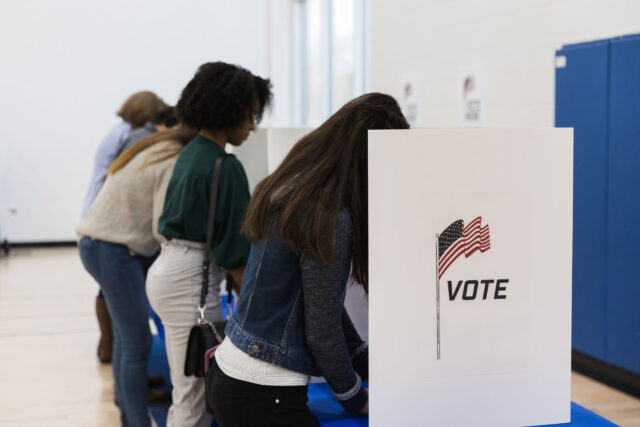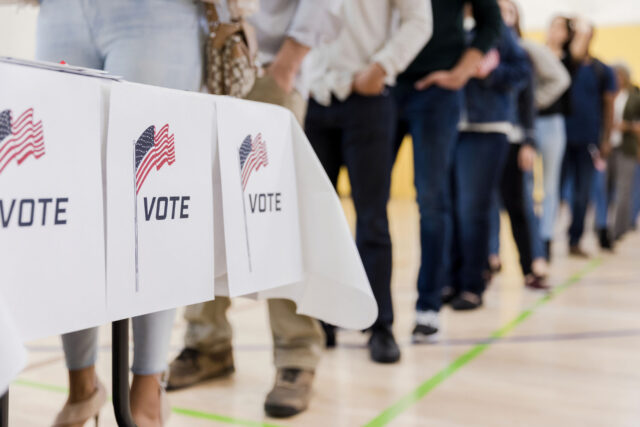California’s exceptional nature was on display again last Tuesday, as Democratic candidates swept the statewide races while Republicans scored big victories in the national midterm elections. An analysis by my PPIC colleagues Eric McGhee and Daniel Krimm shows that the state’s legislative races were closer this time around and a few competitive seats switched parties. In the end, though, the California Legislature and U.S. House delegation remain firmly in the Democratic column.
The exit polls confirmed what we reported in 2014 PPIC pre-election surveys and analyses of likely voters’ profiles. The 15 point voter registration gap between Democrats and Republicans (43% to 28%) narrowed somewhat in this midterm election but not by enough to challenge the deep-blue nature of California politics. The final voter tally is still weeks away, but this election year will likely stand out in California history for record-low turnouts in both the June primary and the November general election.
 The search for the cause of voter apathy has mainly focused on the governor’s race, but I would like to call attention to another exceptional feature of this election: the drop-off in state propositions and citizens’ initiatives, which have often captured media attention and voter interest in the past. It may mark the beginning of a trend with profound implications for voter engagement and state policymaking.
The search for the cause of voter apathy has mainly focused on the governor’s race, but I would like to call attention to another exceptional feature of this election: the drop-off in state propositions and citizens’ initiatives, which have often captured media attention and voter interest in the past. It may mark the beginning of a trend with profound implications for voter engagement and state policymaking.
This year, there were only eight state propositions on the June and the November ballots, including four legislative measures, three citizens’ initiatives, and one referenda. Both legislative measures on the June ballot, Propositions 41 and 42, passed with more than 60 percent of the vote and little fanfare. On the November ballot, two legislative measures, Propositions 1 and 2, also garnered more than 60 percent of the vote. Governor Brown sold them as a package with a “Save Water, Save Money” campaign, tapping into concerns about the state drought and budget shortfalls. Proposition 47, a citizens’ initiative on criminal sentencing, passed with almost 60 percent at a time when fear of crime does not loom large among Californians. The three measures that failed—two citizens’ initiatives on health care, Propositions 45 and 46, and a referendum on Indian gaming, Proposition 48—faced well-funded opponents. Although money was clearly a factor in the outcomes on ballot measures, the $151 million in total spending represents a down year for the campaign consultants in the California initiative business.
 To place this year in context, there were 100 state propositions on state ballots between 2003 and 2013, including 68 citizens’ initiatives, 25 legislative measures, 6 referenda, and the governor’s recall. Total spending for and against the 68 citizens’ initiatives was about $1.8 billion. In fact, since the Proposition 13 era began in 1978, the numbers of state propositions and citizens’ initiatives in midterm and presidential election years has never been lower than in the 2014 election cycle. Why the dramatic change in voter decision making at the ballot box?
To place this year in context, there were 100 state propositions on state ballots between 2003 and 2013, including 68 citizens’ initiatives, 25 legislative measures, 6 referenda, and the governor’s recall. Total spending for and against the 68 citizens’ initiatives was about $1.8 billion. In fact, since the Proposition 13 era began in 1978, the numbers of state propositions and citizens’ initiatives in midterm and presidential election years has never been lower than in the 2014 election cycle. Why the dramatic change in voter decision making at the ballot box?
One contributing factor is SB 202, which had the intended consequence of keeping citizens’ initiatives off the June primary ballot for the first time in decades. Passed by the legislature and signed by the governor in late 2011, this law limits citizens’ initiatives and referenda to the November election, when more voters typically cast ballots. A PPIC report pointed to another potential effect of the law: turnout could fall by 3 to 7 points without initiatives on the primary ballot. While the legislature can still place its proposals on the primary ballot, as it did with Propositions 41 and 42 this June, these measures can lack the sizzle and drama of initiative campaigns. In other words, SB 202 could have the unintended consequence of lower primary turnout.
SB 202 was expected to result in more initiatives on the November ballot, but that did not happen this year. It is possible that some interest groups shied away from the ballot because their causes were more likely to succeed in a primary with a smaller, older, and more conservative electorate. Others may have decided to wait until the presidential election in November 2016 because their causes are better aligned with a larger, younger, and more liberal electorate. Or maybe initiatives have simply become too expensive, even for the interest groups that operate in this arena. In any case, fewer initiative campaigns gave Californians fewer reasons—and fewer televised reminders—to vote this fall.
Because of another new law, SB 1253, we can expect further declines in the number of initiatives on state ballots. Passed by the legislature and signed by the governor this fall, the law offers proponents more opportunities to amend and withdraw their measures, and it requires the legislature to hold public hearings to review initiatives. These types of process changes have strong public support in PPIC Statewide Surveys. By allowing time for reconsideration and providing opportunities for collaboration between initiative proponents and the legislature, SB 1253 may result in fewer citizens’ initiatives and more legislative measures—which would be a throwback to the pre- term limits era before 1990. Such a trend might improve the initiative process, but it could also make elections less interesting for voters.
An early test of SB 1253 will be the marijuana legalization initiative that is on course for the November 2016 ballot. A previous marijuana legalization initiative failed with a 46 percent yes vote in 2010. The October 2014 PPIC Statewide Survey found that 50 percent of likely voters are in favor of legalizing marijuana, so it is far from certain that a 2016 initiative would pass.
Will legislators and proponents search for a compromise before the initiative goes to the voters? Legislators may want to find ways to connect with younger voters in 2016, while proponents may want to bypass costly and risky campaigns. Another reason to think there may be a compromise: the pass rate for legislative measures (71%) has been much higher than the pass rate for citizens’ initiatives (38%) over the past 40 years. If a deal is struck on this high-profile, controversial issue, initiative compromise leading to legislative measures could become the new hybrid model for making policy at the ballot box.
How will voters respond to primaries and general elections with fewer citizens’ initiatives on the ballot? It seems likely that presidential elections will still hold their interest, but primaries and midterm elections might be less compelling. In other words, tinkering with the citizens’ initiative process may unintentionally produce new historic lows in voter turnout. Looking for other tools to engage Californians in elections while improving the initiative process will keep secretary of state–elect Alex Padilla busy over the next four years.





